Chapter 24.08
CORRIDOR STANDARDS AND GUIDELINES
Sections:
I. Overall Corridor Vision/Concepts
24.08.020 Architectural features.
24.08.040 Streetscape and site design.
II. Commercial Corridor Standards and Guidelines
24.08.050 Application of standards and guidelines.
24.08.060 New site development or redevelopment – Standards.
24.08.070 Architectural design of new buildings/additions or substantial exterior remodel.
24.08.080 Landscaping for new site development or redevelopment – Standards.
24.08.090 Signage – Standards.
III. Industrial Corridor Standards and Guidelines
24.08.100 Application of standards and guidelines.
24.08.110 5th Street industrial corridor standards.
24.08.120 Riverside Parkway industrial corridor standards.
I. Overall Corridor Vision/Concepts
24.08.010 Purpose.
The Greater Downtown overlay district standards for the Greater Downtown commercial and industrial corridors in the Rail and River Districts begin to implement goals of the Greater Downtown Plan to (i) improve the visual impact of development along the corridors; and (ii) promote higher quality architectural treatment and site design as new development and redevelopment occurs along the corridors. The visual features identified below define the concepts proposed along the corridors and, as implemented as new development and redevelopment occurs, will shape the desired character of the built environment. The features are grouped into three categories: architectural features; building materials; and streetscape and site design.
(Ord. 4572, 3-20-13)
24.08.020 Architectural features.
(a) Facade Modulation and Roofline Variations. The corridors can be improved through use of visually interesting architectural features that are designed to reduce mass and scale, including variation in the building form with recessed or projecting bays and variation in the rooflines.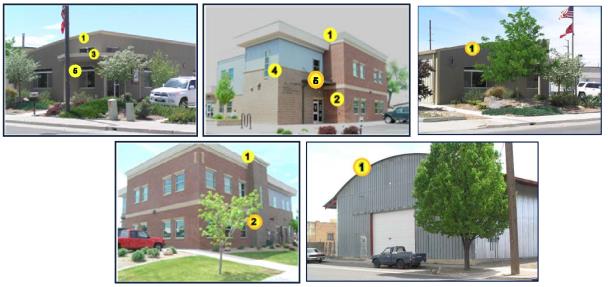
(b) Facade Design. Design details can be used to emphasize architectural features such as the modulation and roof line changes discussed above or other features such as entryways and windows. Facade design details that break up a facade and add visual interest include:
(1) Columns and pilasters that help break up a horizontal plane of a building or other site feature.
(2) Change of material such as on an exterior wainscoting panel.
(3) Accent colors that help define and/or accentuate architectural features.
(c) Defined Entry. Many of the other architectural features above can be used to accentuate and define the primary entrance to a building, add architectural interest, as well as make the building more pedestrian- or customer-friendly.
(d) Window Sizes and Shapes. The shape and sizes of windows used on a building break up the facade, provide visual variety and provide a pedestrian- and customer-friendly character.
(e) Awnings and Porticos. Awnings and porticos are encouraged to help provide architectural interest.
(Ord. 4572, 3-20-13)
24.08.030 Building materials.
(a) Mix of Materials. Variations of materials used on exterior facades break up large building forms and walls.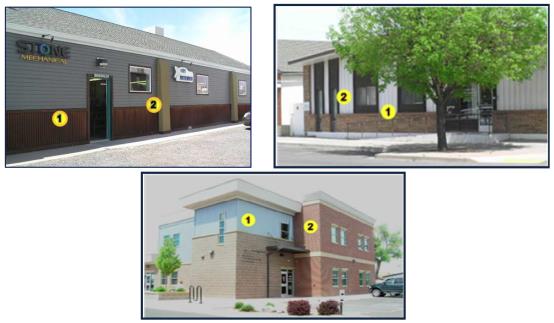
(b) Different Textures, Colors and Tones. Use of different textures, colors and tones provide visual interest and can be used to accentuate architectural features.
(Ord. 4572, 3-20-13)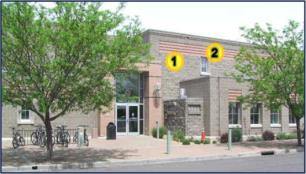
24.08.040 Streetscape and site design.
Streetscape features along the primary corridors within the Rail and River Districts in Greater Downtown also help establish the visual character of the corridors. Examples of the desired characteristics are illustrated below.
(a) Building Placement. Buildings are encouraged to be brought forward on a site to the street or sidewalk.
(b) Landscaping. Many of the streets within the Rail and River Districts do not have, nor are planned to have, a sidewalk. However, streetscape interest can be created through landscaping, encouraging use of xeriscape concepts.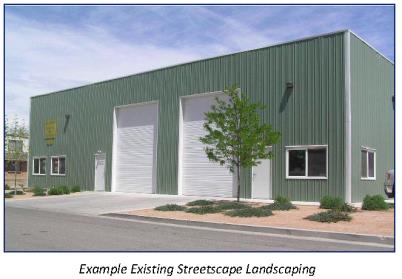
(c) Streetscape Design. An urban streetscape is desired that includes hard surfaces, tree grates and street trees. This design concept exists along some of the corridors in the Rail and River District. The urban streetscape along the street can be blended with the site design of the adjacent parcel so that on-site landscaping complements and enhances the existing streetscape.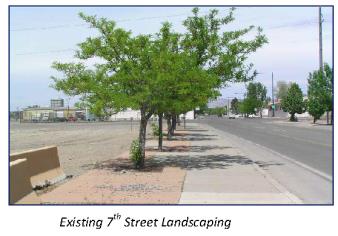
(d) Detached Sidewalks. Where possible, detached sidewalks are desired along the commercial and industrial overlay corridors and already exist along some streets. The park strip between the curb and sidewalk can provide the landscape relief for an abutting developed property.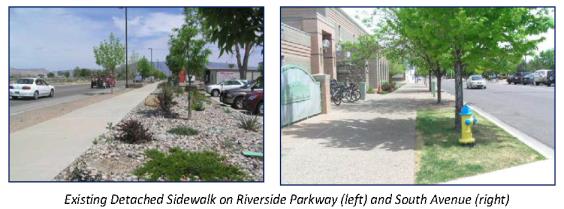
(e) Outdoor Storage, Display and Operations. Minimize the visual impact of outdoor storage, display and operations areas through placement on a site behind a building, to the rear of the property or otherwise screened.
(Ord. 4572, 3-20-13)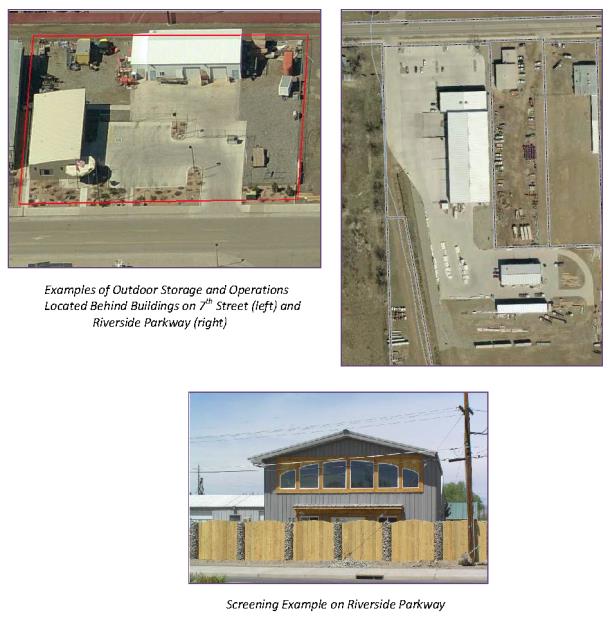
II. Commercial Corridor Standards and Guidelines
24.08.050 Application of standards and guidelines.
The following Commercial Corridor standards and guidelines apply to those parcels on the south side of Pitkin Avenue between 2nd Street and 12th Street as shown in Figure 4: all parcels, or aggregation of parcels to be developed that have frontage on: (i) the east side of 2nd street between Pitkin Avenue and South Avenue; (ii) South Avenue between 2nd Street and 12th Street; (iii) South 7th Street between Pitkin Avenue and the south side of the Riverside Parkway; (iv) Struthers Avenue and Riverside Parkway area from just west of South 7th Street to the alignment of 12th Street; and all parcels between South 7th Street and 12th Street within 100 feet immediately north and south of the centerline of the Riverside Parkway. This area shall be referred to hereafter as the Commercial Corridor.
(Ord. 4572, 3-20-13)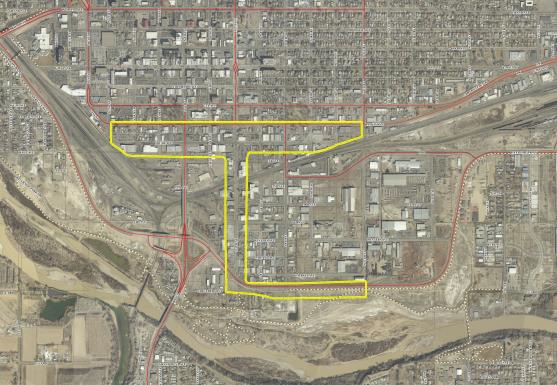
Figure 4
24.08.060 New site development or redevelopment – Standards.
(a) Outdoor storage and permanent display areas shall only be allowed in the rear half of the lot, beside and/or behind the principal structure. For properties with more than one street frontage, the front of the lot shall be considered, for purposes of this standard, to be the side abutting the higher or highest order street. Portable display of retail merchandise may be permitted subject to the provisions of the Zoning and Development Code.
(b) In order to prevent parking from dominating the visual setting of the Commercial Corridor, front yards shall allow only principal structures, landscaping, sidewalks, driveway access to parking areas and signage. No parking shall be allowed in the front yard. All parking that is accessory to a principal use shall be located behind or to the side of the building.
(c) Front yard setbacks for principal structures on parcels within the Commercial Corridor are reduced to zero feet.
(d) Residential uses are allowed as allowed in the Light Commercial (C-1) zone district in the Zoning and Development Code, regardless of how the property is zoned.
(Ord. 4572, 3-20-13)
24.08.070 Architectural design of new buildings/additions or substantial exterior remodel.
(a) Policy. For construction of new buildings and additions, or substantial exterior remodel (see definition under subsection (b)(2) of this section), any facade(s) on all buildings that face a street within the Commercial Corridor shall be designed to relate directly to and reinforce the pedestrian scale and quality of the abutting streets, civic and open spaces.
(b) Standards.
(1) Any facade(s) of a new building, addition or substantial exterior remodel (see definition under subsection (b)(2) of this section) that face a street within the Commercial Corridor or that face the public property containing the Riverfront Trail, shall have visually interesting architectural features and patterns that are designed to reduce mass and scale and reflect the desired vision for the corridors as described in GJMC 24.08.010 through 24.08.040. In order to do so, the facade(s) of a new building, addition or substantial remodel that face a street within the Commercial Corridor shall exhibit a minimum of three of the following nine architectural design elements:
(i) Variation in materials, material modules, expressed joints and details, surface relief and texture to break up building forms and wall surfaces. Such detailing may include sills, headers, belt courses, reveals, pilasters, window bays or similar features.
(ii) Facade articulation/variation such as recessed or projecting bays or pilaster/column projections a minimum of every 30 feet.
(iii) Variation in color.
(iv) Facade feature that emphasizes the primary building entrance through projecting or recessed forms, detail, color and/or materials.
(v) Variation in roof lines/roof materials in order to add interest to and reduce the scale of buildings or expanses of blank wall. This can be accomplished through design elements such as overhangs/eaves, recesses/projections, raised cornice parapets over doors or bays and peaked roof forms.
(vi) Screening of mechanical equipment either located on the roof or on the ground.
(vii) Windows.
(viii) Window or entry awning.
(ix) Other architectural features that achieve the goals of the overall corridor vision/concept as outlined in GJMC 24.08.010 through 24.08.040 as determined by the Director.
(2) Definition of Substantial Exterior Remodel. Exterior building alteration that is greater than or equal to 65 percent of the value of the existing site and building. This increase shall trigger 100 percent site development compliance and 100 percent architectural standards compliance. Value shall be the greater of: total actual value per the Mesa County Assessor; or a current appraisal.
(c) Guidelines.
(1) Exterior building materials should be durable, economically maintained, and of a quality that will retain their appearance over time.
(Ord. 4572, 3-20-13)
24.08.080 Landscaping for new site development or redevelopment – Standards.
On-site landscaping shall be required per the Zoning and Development Code. The total amount of required landscaping may be reduced by the Director if a minimum of two of the following five conditions exist or are proposed:
(a) A higher quality of architectural design is achieved with greater than three of the architectural design elements listed in GJMC 24.08.070.
(b) Fifty percent or more of the building facade is set back no more than 15 feet.
(c) Street trees and other finished landscaping or hardscape exists within the public street immediately in front of the property.
(d) All parking is located to the side and/or rear of the building.
(e) All outdoor storage and operations are located behind the building.
(Ord. 4572, 3-20-13)
24.08.090 Signage – Standards.
(a) Only flush wall and monument style signs are allowed on the parcels that have frontage on 7th Street, Struthers Avenue, and/or Riverside Parkway within the Commercial Corridor. Flush wall signs are allowed in accordance with the Zoning and Development Code. Monument signs shall be a maximum of 12 feet in height with a maximum total of 100 square feet per sign face allowed per parcel. Illumination shall comply with the Zoning and Development Code.
(b) Off-premises signs and billboards as defined by the Zoning and Development Code that did not exist as of April 21, 2013, are not allowed on properties within the Commercial Corridor.
(Ord. 4572, 3-20-13)
III. Industrial Corridor Standards and Guidelines
24.08.100 Application of standards and guidelines.
The following Industrial Corridor standards and guidelines apply to all properties or aggregation of parcels to be developed with frontage on 5th Street or the 5th Street/Riverside Parkway intersection right-of-way, south of South Avenue to the river, referred to hereafter as the 5th Street Industrial Corridor (Figure 5), and on Riverside Parkway from the east edge of 12th Street, extended along the Riverside Parkway, east to 28 Road, referred to hereafter as the Riverside Parkway Industrial Corridor (Figure 6). Please see the maps below. Collectively, the two shall be referred to as the Industrial Corridors.
(Ord. 4572, 3-20-13)
24.08.110 5th Street industrial corridor standards.
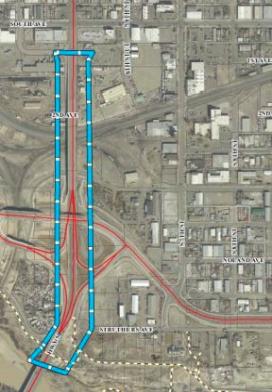
Figure 5
(a) No new outdoor uses and operations shall be allowed on parcels that have frontage on 5th Street or on the right-of-way for the 5th Street/Riverside Parkway interchange. Maximum expansion and construction of any outdoor uses and operations (such as outdoor operation of rail yards, salvage yards, etc.) on properties that abut the 5th Street right-of-way shall be 25 percent of the total square footage as it existed on April 21, 2013.
(b) For uses that require screening per the Zoning and Development Code and will be visible from the elevated portions of the 5th Street viaduct, screening shall be provided on the viaduct that limits views to adjacent uses but still provides longer vistas to the east (Grand Mesa) and west (Colorado National Monument and Uncompahgre Plateau), in accordance with CDOT specifications as follows: 36 inches by three-eighths inches by 11 ga Core, 10 ga finish vinyl coated chain link. The City may accept payment in lieu of screening; the amount of the payment-in-lieu may be established by resolution of the City Council.
(c) Off-premises signs and billboards as defined by the Zoning and Development Code that did not exist as of April 21, 2013, are not allowed on properties within the 5th Street Industrial Corridor.
(Ord. 4572, 3-20-13)
24.08.120 Riverside Parkway industrial corridor standards.
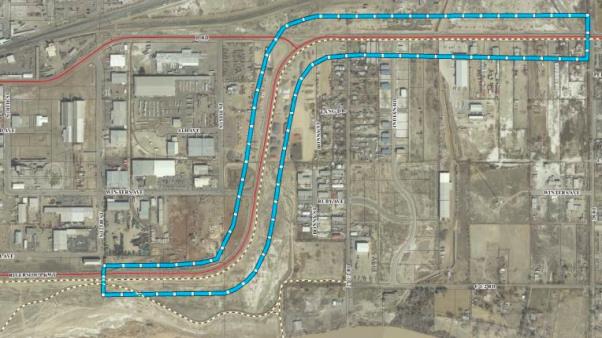
Figure 6
(a) New Site Development or Redevelopment.
(1) Service entrances, service yards and loading areas shall be located only in the rear or side yard. For properties with more than one street frontage, the front yard shall be considered, for purposes of this standard, to be the side abutting the higher or highest order street. The rear and side yards are any other sides that do not meet the definition of a front yard. Along the Riverside Parkway right-of-way, a six-foot-high solid fence or wall of stone, wood or masonry shall screen each service yard or area from adjoining single-family residential zones and uses which are not separated by a street (not counting an alley or any easement).
(2) Outdoor storage and permanent display areas shall be allowed per the zone district of the property. Any storage in the front yard adjacent to the Riverside Parkway right-of-way shall be screened with a six-foot-high solid architectural wall constructed of stone, masonry or combination thereof with a minimum 14-foot landscape buffer provided outside of the wall unless modified per the landscaping in subsection (c) of this section.
(3) The front yard setback for principal structures on parcels within the Riverside Parkway Industrial Corridor is reduced to zero feet.
(b) Architectural Design of New Buildings or Substantial Exterior Remodel.
(1) Any side of a new building, addition or substantial remodel that faces the Riverside Parkway or the public property containing the Riverfront Trail shall exhibit a minimum of three of the following eight architectural design elements:
(i) Variation in materials.
(ii) Facade modulation/articulation a minimum of every 30 feet.
(iii) Variation in color.
(iv) Facade feature that emphasizes the primary building entrance.
(v) Variation in roofline.
(vi) Windows.
(vii) Window or entry awning.
(viii) Other architectural features that achieve the goals of the overall corridor vision/concept as outlined in GJMC 24.08.010 through 24.08.040 as determined by the Director.
(c) Landscaping for New Site Development or Redevelopment.
(1) On-site landscaping shall be required per the Zoning and Development Code. The total amount of required landscaping may be reduced by the Director if a minimum of two of the following five conditions exist or are proposed:
(i) A higher quality of architectural design is achieved with greater than three of the architectural design elements listed in subsection (b) of this section.
(ii) Fifty percent or more of the building facade has no more than a 20-foot setback.
(iii) Street trees exist within the abutting public street.
(iv) All parking is located to the side and/or rear of the building.
(v) All outdoor storage and operations are located behind the building.
(d) Signage.
(1) Only flush wall and monument style signs are allowed on the Riverside Parkway Industrial Corridor properties. Flush wall signs are allowed per the Zoning and Development Code. Monument signs shall be a maximum of 12 feet in height with a maximum total of 100 square feet per sign face allowed per parcel.
(2) Off-premises signs and billboards as defined by the Zoning and Development Code that did not exist as of April 21, 2013, are not allowed on properties within the Riverside Parkway Industrial Corridor.
(Ord. 4572, 3-20-13)


